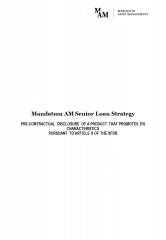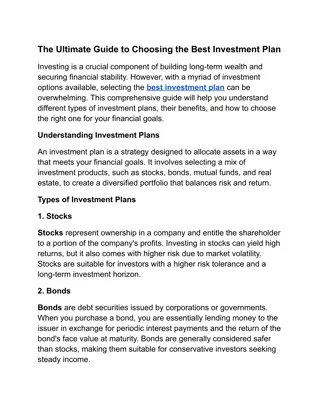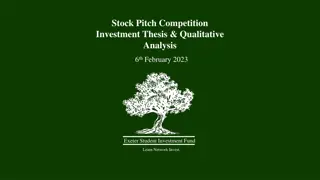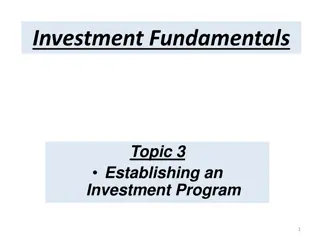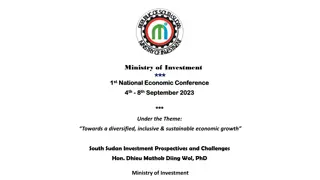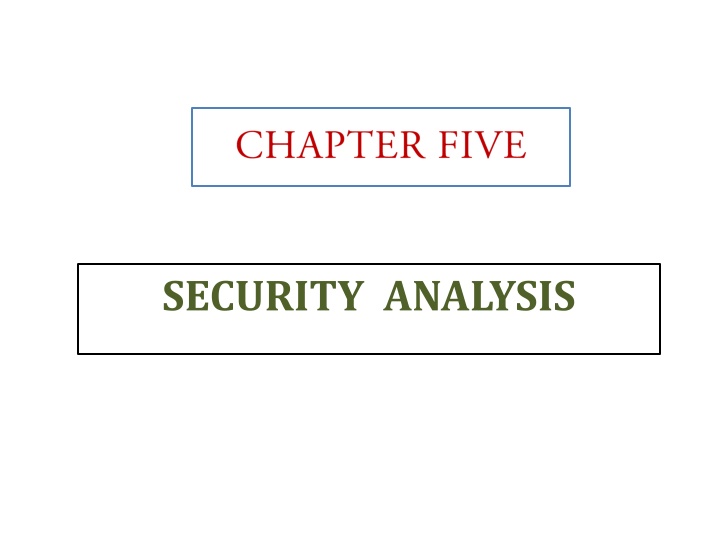
Efficient Market Hypothesis and Security Analysis
Learn about the efficient market hypothesis and its implication on security analysis. Discover the three forms of efficiency and how share prices react to new information in the market.
Download Presentation

Please find below an Image/Link to download the presentation.
The content on the website is provided AS IS for your information and personal use only. It may not be sold, licensed, or shared on other websites without obtaining consent from the author. If you encounter any issues during the download, it is possible that the publisher has removed the file from their server.
You are allowed to download the files provided on this website for personal or commercial use, subject to the condition that they are used lawfully. All files are the property of their respective owners.
The content on the website is provided AS IS for your information and personal use only. It may not be sold, licensed, or shared on other websites without obtaining consent from the author.
E N D
Presentation Transcript
Introduction Security analysis is the means of determining the prices of shares. It follows three security analysis approaches: 1. Market efficiency hypothesis 2. Fundamental analysis and 3. Technical analysis The Efficient Market Hypothesis An efficient capital market is one in which security prices adjust rapidly to the arrival of new information and, therefore, the current prices of securities reflect all information about the security.
Efficient Market Hypothesis/Theory (EMH) and Its Implication This topic/section deals with the efficient market hypothesis and its implication for determination of share prices. There are various theories which seek to provide a rationale for share price movement. The most important of these is the efficient market hypothesis, which provides theoretical underpinning for how markets take into account new information. The chapter also looks at practical issues. Definition of Efficient Markets: An efficient capital market is a market that is efficient in processing information. We are talking about an informationally efficient market, as opposed to a transactionally efficient market. In other words, we mean that the market quickly and correctly adjusts to new information. In an informationally efficient market, the prices of securities, such as share, observed at any time are based on correct evaluation of all information available at that time. Therefore, in an efficient market, prices immediately and fully reflect available information.
Definition of Efficient Markets Professor Eugene Fama, defined market efficiency as follows: "In an efficient market, competition among the many intelligent participants leads to a situation where, at any point in time, actual prices of individual securities already reflect the effects of information based both on events that have already occurred and on events which, as of now, the market expects to take place in the future. In other words, in an efficient market at any point in time the actual price of a security will be a good estimate of its intrinsic/true value." that information. Fama, Eugene, "Random Walks in Stock Market Prices, Financial Analysts Journal , 1965. fully reflects the available
Contd The theory behind share price movements can be explained by the three forms of the efficient market hypothesis. 1.Weak form efficiency implies that prices reflect all relevant information about past price movements and their implications. 2. Semi-strong form efficiency implies that prices reflect past price movements and publicly available knowledge. 3. Strong form efficiency implies that prices reflect past price movements, publicly available knowledge and inside knowledge. The efficient market hypothesis provides a rationale for explaining how share prices react to new information about a company, and when any such change in share price occurs. Stock market reaction to new information depends on the strength of the stock market efficiency.
Strong form efficiency The strong form says that prices fully reflect all information, whether publicly available or not. Even the knowledge of material, non-public information cannot be used to earn superior results. Most studies have found that the markets are not efficient in this sense. Studies have shown that insiders and specialists often earn excessive profits, but mutual funds do not.
The Weak Form The weak form of the EMH says that past prices, volume, and other market statistics provide no information that can be used to predict future prices. If stock price changes are random, then past prices cannot be used to forecast future prices. Most research supports the notion that the markets are weak form efficient. Nisar and Muhammad Testing Weak Form of Efficient Market Hypothesis: Empirical Evidence from South- Asia World Applied Sciences Journal 17 (4): 414-427, 2012 47
The Semi-strong Form The semi-strong form says that prices fully reflect all publicly available information and expectations about the future. This suggests that prices adjust very rapidly to new information, and that old information cannot be used to earn superior returns. Most studies find that the markets are reasonably efficient in this sense, but the evidence is somewhat mixed. Raja, Sudhahar, Selvam Testing the Semi-Strong form Efficiency of Indian Stock Market with Respect to Information Content of Stock Split Announcement A study in IT Industry International Research Journal of Finance and Economics 25, 7-20, 2009
Features of efficient markets Stock markets that are efficient (or semi-efficient) are therefore markets in which: (a) The prices of securities bought and sold reflect all the relevant information available to the buyers and sellers, and share prices change quickly to reflect all new information about future prospects. (b) No individual dominates the market. (c) Transaction costs of buying and selling are not so high as to discourage trading significantly. (d) Investors are rational and so make rational buying and selling decisions, and value shares in a rational way. (e) There are low, or no, costs of acquiring information.
Contd Impact of efficiency on share prices: If the stock market is efficient, share prices should vary in a rational way. (a) If a company makes an investment with a positive net present value (NPV), shareholders will get to know about it and the market price of its shares will rise in anticipation of future dividend increases. (b) If a company makes a bad investment, shareholders will find out and so the price of its shares will fall. (c) If interest rates rise, shareholders will want a higher return from their investments, so market prices will fall.
Implications of efficient market hypothesis for the financial manager If the markets are quite strongly efficient, the main consequence for financial managers will be that they simply need to concentrate on maximising the net present value of the company's investments in order to maximise the wealth of shareholders. Managers need not worry, for example, about the effect on share prices of financial results in the published accounts because investors will make allowances for low profits or dividends in the current year if higher profits or dividends are expected in the future. If the market is strongly efficient, there is little point in financial managers attempting strategies that will attempt to mislead the markets. (a) There is no point for example in trying to identify a correct date when shares should be issued, since share prices will always reflect the true worth of the company. (b) The market will identify any attempts to window dress the accounts and put an optimistic spin on the figures.
Contd (c) The market will decide what level of return it requires for the risk involved in making an investment in the company. It is pointless for the company to try to change the market's view by issuing different types of capital instruments. Similarly if the company is looking to expand, the directors will be wasting their time if they seek as takeover targets companies whose shares are undervalued, since the market will fairly value all companies' shares. Only if the market is semi-strongly efficient, and the financial managers possess inside information that would significantly alter the price of the company's shares if released to the market, could they perhaps gain an advantage. However attempts to take account of this inside information may breach insider dealing laws.
1.FUNDAMENTAL ANALYSIS In order to make a rational and scientific investment decision, an investor has to evaluate a lot of information as to the part as well as the expected future performance of companies, industries and the economy as a whole in advance such evaluation or analysis is known as fundamental analysis.
Fundamental Analysis thus involves in 3 steps Economic analysis Industry analysis Company analysis
1. Macroeconomic analysis Macroeconomic current economic environment and its effect on industry fundamentals The macro economy is the environment in which all firms operate. Any macro economic forecast should include estimates of all of the important economic numbers, including: analysis: evaluates and company
The performance of a company depends much on the performance of the economy. If the economy is BOOM, the industries and companies in general said to be prosperous. On the other hand, if the Economic Analysis economy is in RECESSION, the performance of companies will be generally poor. Investors are interested in studying those economic varieties, which affect the performance of the company in which they proposed to invest. An analyzed of those economic variable would give an idea about future corporate earnings and the payment of dividends and interest to investors.
Continued. We shall now discuss some of the key economic variables that can investor must monitor as part of this fundamental analysis: (1) GDP (2) Savings and Investment (3) Inflation (4) Agriculture (5) Rates of Interest (6)Govt. Revenue, Expenditure & Deficits (7) Infrastructure (8) Monsoon (9) Political Stability (10)Foreign exchange (Global Economy)
(1) GDP The measure of the economy s total production of goods and services. GDP indicates the rate of growth of the economy. Rapid growth in GDP indicates an expanding economy and higher sales for the firms. It represents the aggregate value of goods and services produced in the economy. The growth rate of economy points out the prospects for the industrial sector and the return investors can expect from investment in shares. The higher growth rate is more favorable to the stock market. measures the economy s total output of goods and services
(2) Savings and Investment Savings and investments represent that portion of GNP which is saved and invested. It is obvious that growth requires investment which in turn requires substantial amount to domestic savings. Stock market is a channel through which the savings of the investors are made available to the corporate bodies. A higher level of savings and investments, accelerates the pace of growth of the stock market.
(3) Inflation The rate at which the general level of prices rise. Inflation has considerate impact on the performance of companies. Higher rates of inflation upset business plans and eat into purchasing power in the hands of consumers. This will result in lower demand for products. Thus high rates of inflation in an economy are likely to affect the performance of companies adversely. However industries and companies prosper during periods of low inflation. Hence an investor has to evaluate the inflation rates prevailing in the economy currently as well as the trend of inflation likely to prevail in the future.
(5) Rates of Interest The cost and availability of credit for companies are determined by the rates of interest prevalent in an economy. A low interest rate stimulates investment by making credit available easily and cheaply. As a result cost of finance for companies decreases which assures higher profitability. On the other hand, higher interest rates result in higher cost of production, which may lead to lower profitability and lower demand. Hence an investor has to consider the interest rates prevailing in the economy and evaluate their impact on the performance and profitability of the companies.
(6) Govt. Revenue, Expenditure & Deficits Government is the largest investor and spender of money. So the trends in government revenue expenditure deficits have a significant performance of industries and companies. So the investor has to evaluate these carefully to assess their impact on his investments. large deficit means more borrowing, which implies higher interest rate. impact on the
Budget Deficit The difference between government spending and revenues. The deficit should be closed by borrowing. The government borrowing can increase interest rates and crowd-out the private borrowing and decrease investment and affect economic growth negatively.
(7) Infrastructure Facilities The development of an economy very much on the availability of infrastructure. It includes electricity, roads and railways, communication channels, sound banking and financial sectors etc. The availability of infrastructural performance of companies. While inadequate infrastructure leads to inefficiencies, lower productivity, wastage and delays and vice versa. Thus an investor should assess the status of infrastructural facilities available in the economy before finalizing his investment avenues. facilities affects the
(8) Monsoon and Agriculture Agriculture is directly and indirectly linked with the industries. Ex:- Sugar, Cotton, Textile and Food processing industries agriculture for raw-material. A good monsoon leads to higher demand for input and results in bumper crop. This would lead to good spirit in the stock market. When the monsoon is bad, agricultural and power production would suffer. They cast a shadow on the share market. depend upon
(9) Political Stability A stable political environment is necessary for steady and balanced growth. No industry or company can grow and prosper when the country is passing through political instability. The long term economic policies are needed for industrial growth. Stable policies can be framed only by stable political systems.
(10)Exchange rate The rate at which domestic currency can be converted into foreign currency. Affects the international competitiveness of the country. The depreciation of domestic currency makes the domestic products cheaper in foreign countries and increases the exports and hence the GDP growth.
2. INDUSTRY ANALYSIS Industry analysis indicates to an investor whether the industry is a growth industry or not. It gives an investor a choice of the industry in which the investments should be made. Industry analysis refers to an evaluation of the relative strength and weakness of particular industries which can be divided in to three parts, viz., 1. Life cycle of an industry 2. Characteristics of an industry 3. Profit potential of an industry
1. Life cycle of an industry Marketing experts believe that each product has a life cycle. In the same way industry is also said to have a life cycle. They are a. Pioneering Stage: Technology and product are newly introduced. There would be severe competition and only fittest companies survive this stage. The producers try to develop brand name, differentiate the product and create a product image. The severe competition often leads to the change of position to the firms in terms of market shares and profit. In this situation, it is difficult to select companies for investment because the survival rate is unknown.
Cont,,,, Pioneering development. During this start-up stage, the industry experiences modest sales growth and very small or negative profits. The market for the industry s product or service during this stage is small, and the firms incur major development costs.
Cont,,,, (b) Growth and Expansion stage: This stage starts with the appearance of surviving firms from the pioneering stage. Companies in this stage stabilize their prices, develop a market of their own and follow their own strategies. Ultimately, by showing their competitive strength, the firms are able to maintain their position in the market. This is the best time for the investor to make an investment in companies expansion stage. The investors can get high returns because demand exceeds supply of the product. passing through the
(c) Stagnation Stage: In this stage the growth of the industries Stabilizes. Moreover, sales increases at slower rate. The industry realizes that it cannot expand further. To keep going, technological production process and products should be introduced. So, the companies who have taken note of the arrival of stagnation stage have to change their course of action. Likewise, investors too should evaluate their investment in such industry on a continuous basis. innovations in the
Cont,,,, (d) Decay stage: In this stage, demand for the particular product and the earnings of the companies in the industry decline. The specific future of the declining stage is that even in the boom period, the growth of the industry would be low and decline at a higher rate during the recession. It is better to avoid investing in the shares of the low growth industry even in the boom period. Investment in the shares of these companies leads to erosion of capital.
2. Characteristics of an industry In an Industry Analysis the analyst should consider a number of key characteristics: Relationship between Demand & supply Nature of the product Nature of the competition Growth of the industry Labor Government policy Availability of Raw Material Research and development
3. Profit potential of an industry Specifically, a critical factor affecting the profit potential of an industry is the intensity of competition in the industry, as Porter has discussed in a series of books and articles. (i) Threat new entrants: New entrants inflate cost, push down the prices and reduce profitability. An industry which is well protected from the entry of new firms would be ideal for investment. (ii) Competitions among existing firms: The firm competes with each other on the basis of price, quality, promotion, service, warranties and so on. If the competition between the firms in an industry is strong average profitability of the industry may be discouraged.
(iii) Pressure from substitute products: Each firm in an industry face competition from other firms in the same industry producing substitute products. Ex:- Sony T.V, Samsung T.V etc.. Substitute products may affect the profit potential of the industry badly. The pressure from the substitute products is found to be high under the following circumstances: (a) When the price of the products is attractive (b) When the cost for the prospective buyers to switch over to a substitute product is minimum. (c) When the substitute products are earning greater profits.
(iv) Bargaining power of buyers: Buyers can bargain for price reduction asks for better quality and better service. The bargaining power of a buyer group is said to be high under the following conditions: (a) If its capacity to buy is more than the capacity of the seller to sell. (b) If the cost of the switch over to a substitute product is low.
(V)Bargaining Power of Suppliers Bargaining Power of Suppliers Suppliers can suppress the profitability of the industries to which they sell by raising prices or reducing the quality of the components they provide. If a supplier reduces the quality of the components it supplies, the quality of the finished product will suffer, and the manufacturer will eventually have to lower its price. If the suppliers are powerful relative to the firms in the industry to which they sell, industry profitability can suffer. 5-38
3. COMPANY ANALYSIS It involves a close investigative scrutiny of the companies financial and non financial aspects with a view to identifying its strength, weaknesses and future business prospects. The financial and non financial aspects are as follows: Marketing success Accounting Policies Profitability Capital Structure Financial Analysis
Marketing success The success of the market of the firm depends on (a) The market share of annual sales (b) Growth of annual sales (c) The stability of annual sales. (d) Sales forecast
Marketing success Sales Revenue (growth) Profitability (trend) Product line (turnover, age) Output rate of new products Product innovation strategies R&D budgets Pricing Strategy Patents and technology
Accounting Policies While analyzing a company, the investor should carefully consider the accounting policies followed by the company. A. Inventory Pricing Generally, the prices of inventory change over a period of time. Due to changes in the prices of the inventory, the value of inventory changes during an accounting year. Ex:- FIFO and LIFO B. Depreciation methods The amount of depreciation varies depending upon the method employed. Higher amount of depreciation reduces profit while the lower amount of depreciation increases profit. Straight line method Diminishing balance method C. Non operating income Non-operating incomes are those items of incomes which are not earned in the routine business of the company. Dividend Interest D. Tax Carry over A company must take adequate provisions for payment of tax on its earnings. Further, excess tax paid in the previous year may be refunded in the current year and such refund may be adjusted against the tax due in the current year. The incidence of corporate tax and tax carryover are the factors which the investor should carefully take into consideration.
Organizational performance and Management functions Organizational performance Effective application of company resources Efficient accomplishment of company goals Management functions Planning - setting goals/resources Organizing - assigning tasks/resources Leading - motivating achievement Controlling - monitoring performance
Evaluating Management Quality Evaluating Management Quality Age and experience of management Strategic planning Understanding of the global environment Adaptability to external changes Marketing strategy Track record of the competitive position Sustainable growth Public image Finance Strategy - adequate and appropriate Employee/union relations Effectiveness of board of directors
Capital Structure Generally, companies raise long term funds through the issue of shares and other securities like bonds, debentures etc. The capital structure affects return on the equity shareholder s investment. Equity holders return can be increased by using more debts than equity capital. So the investor should study the company s capital structure before take decision.
Financial Analysis The financial statement of the a company provide the best possible information about the profitability and financial soundness of the company. This is the primary source of information for evaluating the prospects of the investment in company s stock. The statement gives the historical and current information about the company s operations. Balance Sheet Analysis
Financial Analysis Balance Sheet Snapshot of company s Assets, Liabilities and Equity. Income statement Sales, expenses, and taxes incurred to operate Earnings per share Cash flow statement Sources and Uses of funds Are financial statements reliable? G.A.A.P.
Financial Ratio Analysis Financial Ratio Analysis Liquidity (ability to pay bills) Debt (financial leverage) Profitability (cost controls) Efficiency (asset management) DuPont Analysis Top-down analysis of company operations Objective: increase ROE
Liquidity Ratios Measure ability to pay maturing obligations Current ratio Current assets / current liabilities Quick ratio (Current assets less inventories) / current liabilities

